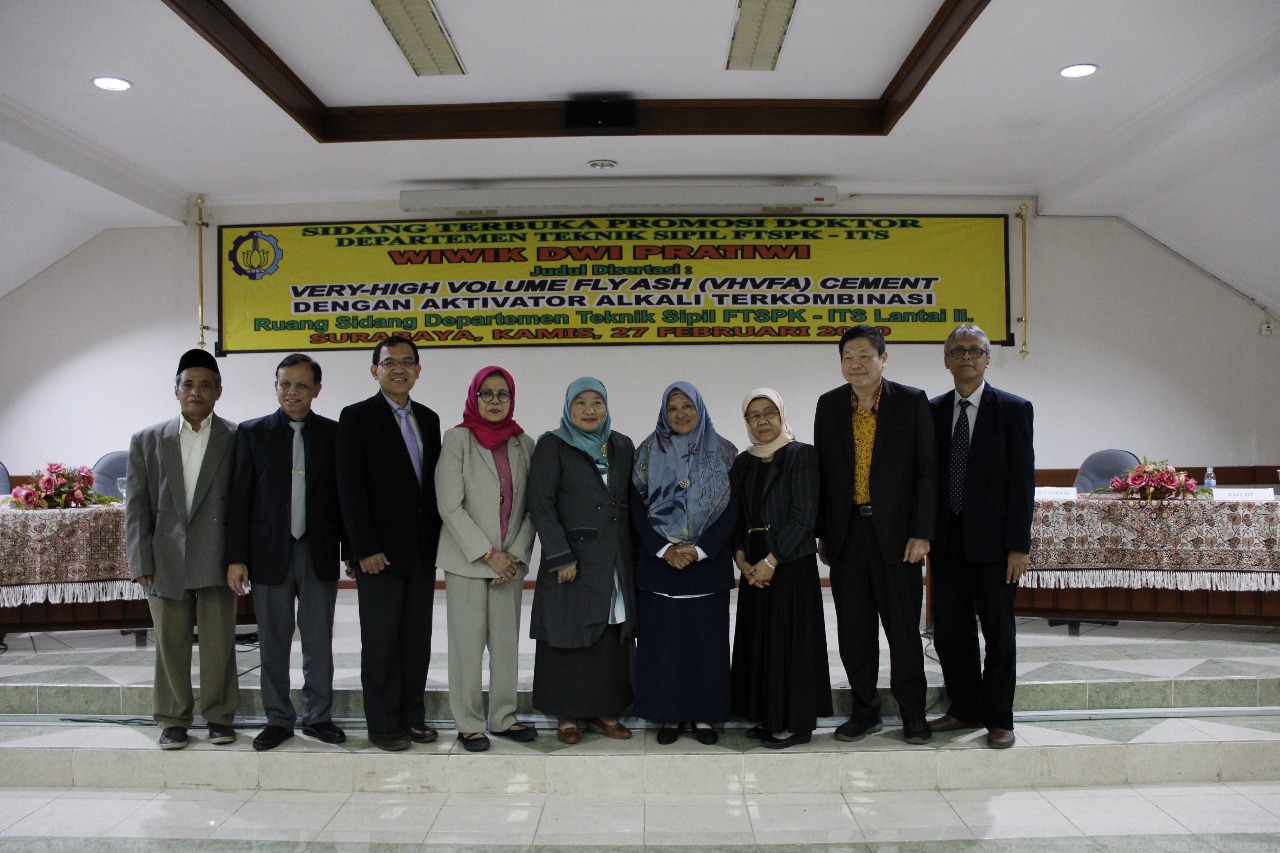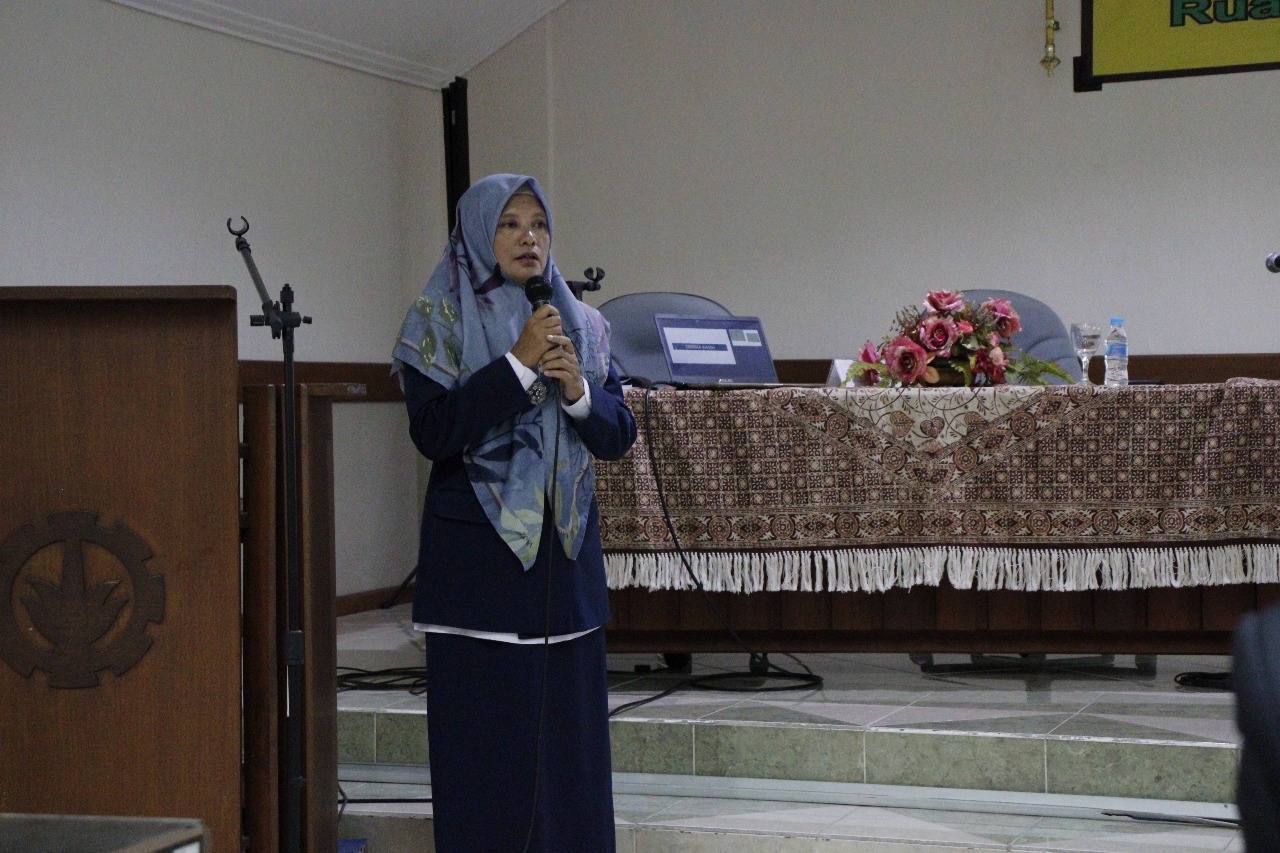Reducing the Pollution, A Doctor From ITS Utilizes Fly Ash to Strengthen Concrete

Wiwik Dwi Pratiwi (fourth from right) with the examiners and promotors after the open session of doctoral promotion in the Department of Civil Engineering ITS
ITS Campus, ITS News – Solid waste from coal combustion, also known as fly ash, is still commonly found piled up some regions in Indonesia. Concerned about these conditions, Wiwik Dwi Pratiwi from the doctoral program of the Department of Civil Engineering, Institut Teknologi Sepuluh Nopember (ITS) conducted a study using high levels of fly ash for cement mixture in order to strengthen concrete.
The dissertation titled Very-High Volume Fly Ash (VHVFA) Cement with the Combined Alkali Activator was successfully presented at an open doctoral session in the ITS Civil Engineering Department last week. The accumulation of fly ash can certainly pollute the surrounding environment. Therefore, in her research, Wiwik tries to reduce the existing build-up.
In her research, Wiwik used fly ash from various Steam Powered Electric Generator (Pembangkit Listrik Tenaga Uap – PLTU, red) in Indonesia. Among them, there are PLTU Paiton, PLTU Tanjung Jati, PLTU Bayah, etc. Not only from the PLTU, Wiwik also obtained samples from Petrochemicals. “I was assisted by my promotor in terms of getting fly ash samples,” she added.
The woman who works as a lecturer at Politeknik Perkapalan Negeri Surabaya (PPNS) uses 80 percent of fly ash into her cement mixture. This method is different from other studies that only use fly ash at levels of 0 – 70 percent. That is one of Wiwik’s focuses in her dissertation. “I really want to use fly ash with high levels in this study,” she said.
The woman who is also Chemical Engineering Alumni University of Gadjah Mada (UGM) explained, the addition of high levels of fly ash was carried out because it had several aims and objectives. In addition to reducing its buildup in Indonesia, high levels of fly ash are also considered to be able to strengthen the cement mixture to be used. “The addition of fly ash is already known to increase the strength of cement,” she explained.

Wiwik Dwi Pratiwi when delivering his dissertation in front of examiners in the open session of doctoral promotion in the Department of Civil Engineering ITS
Wiwik stated, fly ash has a low reactivity so it needs the addition of activators to activate fly ash with high levels. The process of finding the right composition of the activator on the fly ash becomes her next focus. Activators that she discovered are Precipitated Calcium Carbonate (PCC) and NaOH solution. Those activator are considered to be able to increase the compressive strength of cement with very high levels of fly ash.
Furthermore, the lecturer born in Grobogan, Central Java, said that another focus in her research is to identify the nature of fly ash. This needs to be done because fly ash has very diverse properties. The nature and characteristics of the fly ash also determine the level of cement strength. “I did this so that the fly ash characteristics were of good quality,” she explained.
After conducting research, Wiwik also explained the characteristics of good quality fly ash. The nature and characteristics of fly ash in terms of morphane, levels of CaO, silicon (Si) dissolved in NaOH solution, and grain size. “The finer the better, the more amor the better, and the more dissolved Si the better,” she explained.
Wiwik revealed that there were still more problems she wanted to solve related to this fly ash. Wiwik hoped that her research will continue and not stop here. In addition, Wiwik also hoped that cement with very high levels of fly ash can be utilized in life, one of which is a building for the sea. “Cement with very high levels of fly ash is well suited for sea areas,” she concluded. (dil/sel/ITS Public Realtion)
Related News
-
ITS Rises to Second Rank in Most National PKM Funding
ITS Campus, ITS News – Strengthening its determination in the scientific field, the Institut Teknologi Sepuluh Nopember (ITS) succeeded
July 10, 2020 20:07 -
Examining Kenny, the Best ITS Bachelor Graduate with a GPA of 3.94
ITS Campus, ITS News — Educating for 3.5 years at the Institut Teknologi Sepuluh Nopember (ITS) did not prevent Benedictus
July 10, 2020 20:07 -
Inspirational, Deaf ITS Graduates Graduated with Cumlaude Predicate
ITS Campus, ITS News — An inspiring story was also present at the 129th Graduation Ceremony of the Institut Teknologi
July 10, 2020 20:07 -
129th Graduation: ITS Graduates 1,355 Candidate Leaders
ITS Campus, ITS News – Institut Teknologi Sepuluh Nopember (ITS) again held a graduation procession for its students through the
July 10, 2020 20:07
